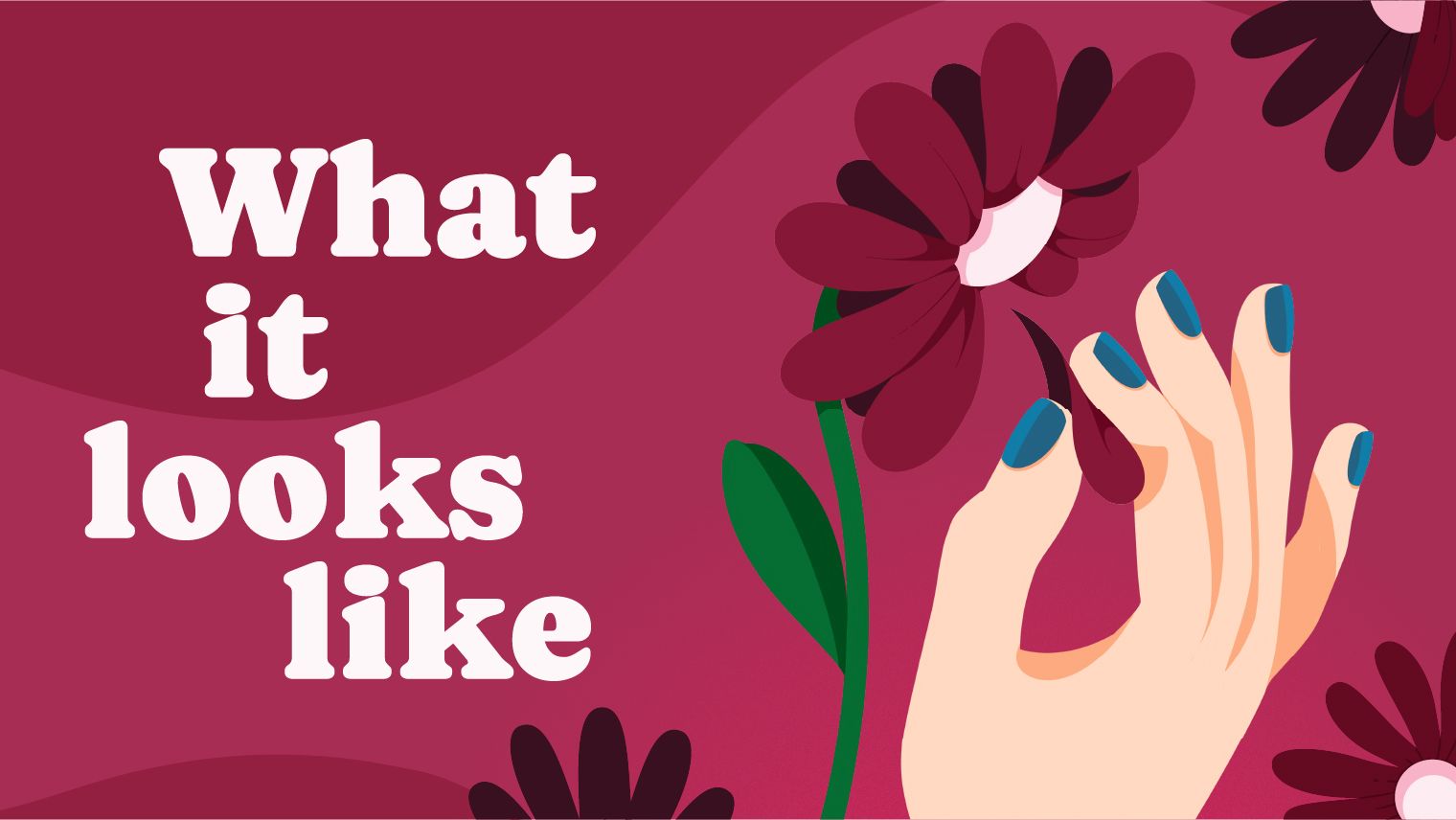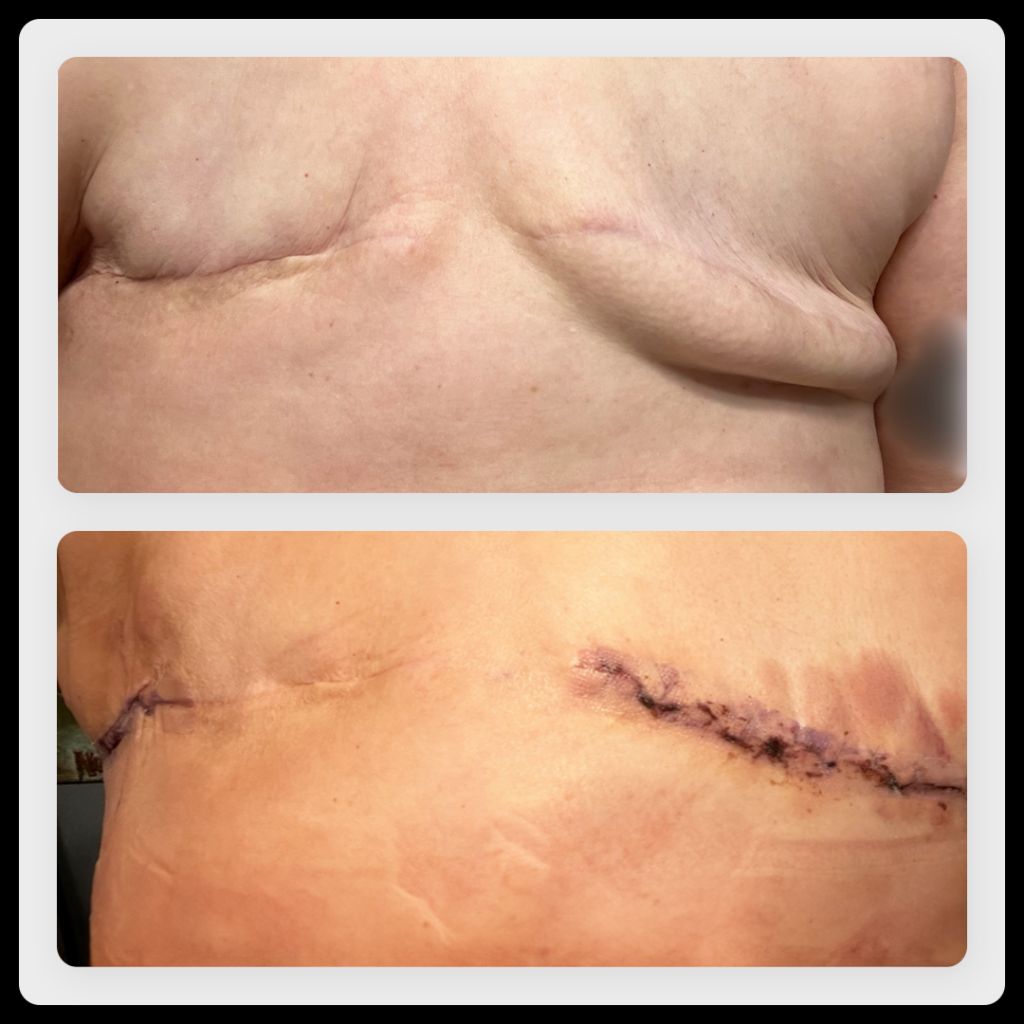You Have Choices: Double Mastectomy and Flat Closure with Scar Revision
August 30, 2024
Content created for the Bezzy community and sponsored by our partners. Learn More

Illustration by Brittany England
Before cancer, I was a people pleaser. Now, I advocate for myself in every aspect of my life.
- Procedures: double mastectomy, flat closure, scar revision
- Years of procedures: 2021, 2023
- Age: 28 years old
- Race or ethnicity: white
This article contains graphic, intimate images of a postsurgery body. The photos have been generously shared by a breast cancer survivor so that others can benefit from uncensored visual information that may help them make important surgical decisions for themselves.


My diagnosis
When I was in high school, my gynecologist ordered a breast ultrasound because I had dense tissue. Years later, I found a large lump during a self-exam while showering. I was about to start my period, so I waited to see if it was just related to my cycle.
The lump didn’t change, so I called my primary care practitioner (PCP). I worried about getting an appointment because it was during the peak of the COVID-19 pandemic in June 2020. But when they heard the word “lump,” they scheduled me within a week.
During the appointment, I was frustrated because the first thing the nurse practitioner mentioned was my weight, not the lump. I’d put on weight, which I believe was related to the cancer and hormones. When she finally felt the lump, she asked if I’d told my parents about it. I said no, and she said I should. That worried me, of course, and I told my mom that day.
Everything happened quickly after that. During my biopsy and ultrasound, the radiologist said the lump didn’t look like cancer. I’m honestly glad he said that, even though he was wrong, because it gave me a break from anxiety for 24 hours.
When my PCP called me the next morning, we cried on the phone together. She said, “We got your results, and it’s not good. It’s invasive ductal carcinoma.” I honestly didn’t know it was cancer until I Googled it after the call because she never said the word “cancer.” I didn’t know what questions to ask. I was only 28 years old.
My younger brothers took it really hard. My parents came over right away to support me and put on a brave face in front of me, but I knew they were taking it hard, too.
Making a treatment plan
The majority of my medical team were women, which I loved and thought was badass. In another life, I’d love to be an oncology nurse because of how great they were.
For the most part, I didn’t have a choice in my treatment plan because it was stage 3. But I trusted my doctors and knew they’d get rid of the cancer in the best way.
About a month after my diagnosis, I had an egg retrieval procedure and froze 11 eggs. Then, I had eight sessions of chemotherapy.
More like this
- Lifesaving Scars: Double Mastectomy and Aesthetic Flat Closure
- Second Time’s the Charm: Double Mastectomy and Implant Reconstruction without Nipple
- It Takes Time: Single Mastectomy with Implants and Nipple Reconstruction
- I Know It’s Not Me: Double Mastectomy to Flat Closure to DIEP Flap with No Nipple
My breast surgeon, who I loved, said I wasn’t a candidate for a lumpectomy due to the size of my tumor. It was 12 centimeters across and about the size of a clementine.
She suggested a single mastectomy, but I was very firm that I wanted a double mastectomy. I had high anxiety before the cancer, and I knew I’d hyper-fixate on new cancer developing in my other breast if it stayed.
Choosing flat closure
A lot of people in my life are breast cancer survivors. Both my grandmothers had it, and one was diagnosed in her 30s. They both had a single mastectomy without reconstruction and no issues afterward.
Two of my mom’s friends also had complications from breast reconstruction with more surgery and hospital stays. I didn’t want more surgery than necessary.
I didn’t do genetic testing until the day after my diagnosis. But I always had a feeling I would get breast cancer young. I can’t explain it, but ever since that ultrasound in high school, I just knew. I decided back then that if or when I got breast cancer, I’d get both breasts removed without reconstruction.
The plastic surgeon pushed for me to have breast reconstruction and seemed annoyed that I didn’t want it. But I still chose flat closure.
Unfortunately, I didn’t know I should bring photos of what I wanted and that I should’ve used the words “aesthetic flat closure.” My cancer side ended up flat, but my noncancer side had excess skin that you could see through my clothes — I was self-conscious of that.
My doctor didn’t mention aesthetic flat closure to me as an option. I didn’t even know the term “aesthetic flat closure” until after my surgery when I joined a support group on Facebook — which still frustrates me. I wish I’d known better questions to ask.
My double mastectomy experience
I was in a depressive state during chemotherapy, but I was very ready for surgery. I wanted the cancer out of my body. It was a big step toward the end of this chapter of my life.
After one night in the hospital, I was released and stayed with my supportive parents for over a week. I was single at the time, and I needed help to shower and take care of my drains. Two of my drains were removed a week after surgery, and the third I had for 2 weeks.
I was very down until my drains were removed — then I felt so, so much better. There were no complications during or after surgery.
For the rest of my treatment after surgery, I had 35 rounds of radiation. My right chest and underarm and the right part of my neck turned dark gray from radiation burns, but that went away over time. The scar tissue in my underarm is still raised and thick.
Two years later, I had scar revision surgery with a different plastic surgeon, and my chest was finally flat and symmetrical.

How my perspective has changed
I have a much easier time saying “no” now. Before cancer, I was a people pleaser who put everyone else first and avoided conflict. I have no problem with that now.
Life is too short to do things you don’t want to do, or that don’t bring you joy.
I also advocate for myself in every aspect of my life. I’m a teacher, and I’ll push back when something is unfair. I used to keep quiet. I no longer let people talk to me or my people in a negative way.
What I want others to know
I want others to know they have choices. You have time to do research and get second opinions. You may not have weeks to decide, but you definitely have a day or two. These huge, life changing decisions usually don’t have to be made then and there.
If reconstruction is what you choose, that is amazing. No matter what you want, bring photos of what you hope for. If you’re told no, you have every right to find another surgeon who will say yes.
I hope you advocate for yourself or bring someone to your appointments who will advocate for you. It’s important to find support and learn how to ask for help. Doctors should have support group resources available, and there are many support pages on social media, too.
If you’re going through this, let yourself feel all of the emotions. Don’t stifle them. If you feel like you have to put on a brave face, find someone you can vent to.
Hearing, “You’re right. This sucks. I am so angry, too,” are words that helped me more than words of sympathy, though I appreciated those, too.
Sometimes, you just need to get it all out without someone trying to solve it.
Bezzy BC and Young Survival Coalition are partnering to create What It Looks Like, a series showcasing photographs of different breast reconstruction choices on bodies of all shapes, sizes, and colors.
We’re spotlighting the breast reconstruction decisions of people who have had breast cancer so that other people facing mastectomy surgery can see and hear about many different real-life outcomes.
If you’d like to share your reconstruction (or flat closure) images and story, we’d love to hear from you. Just have your photos ready and fill out this submission form.
Images and stories will be anonymously published on BezzyBC.com.
Medically reviewed on August 30, 2024


Like the story? React, bookmark, or share below:
Have thoughts or suggestions about this article? Email us at article-feedback@bezzy.com.
About the author